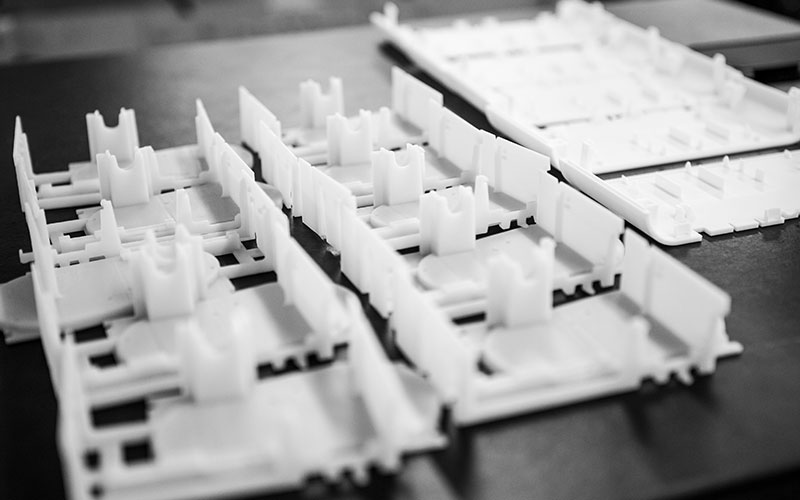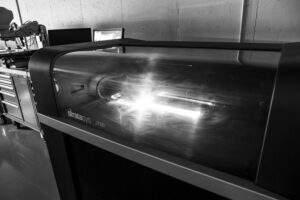
By Dianna Brodine, managing editor, The American Mold Builder
Applications for additive manufacturing grow on a daily basis. From custom shoes to complex aerospace applications to medical interventions, new technologies in both machines and materials are expanding the realm of possibility for a process that’s been around for more than three decades, even as its popularity has exploded in the last five years.
Byrne Tool + Design, a tool and die shop in Rockford, Michigan, has had more than six years to explore the applications and advantages in additive manufacturing, starting where all manufacturers start – jigs and fixtures – and transforming its skill sets to increase the value to its own organization and its customers. Whether modeling prototype parts, building fixtures for internal processes, reverse-engineering damaged molds or exploring small-scale production, Byrne Tool is embracing what 3D printing can do for the mold building industry.
From exploration to standard process
In 2014, Byrne Tool invested in its first additive manufacturing machine, driven by the desire to speed turnaround time for customer projects by insourcing work that was being sent to outside vendors. “We do a lot more than injection mold building,” said Marc Mitchell, additive manufacturing business development manager. “We also do development work for our customers. We were outsourcing a lot of the printed parts or fixtures that our customers wanted done, but we realized we could get parts for them faster if we had our own machine.”
The first purchase was a Stratasys Fortis 250MC, a 3D printer using fused deposition modeling (FDM) technology. During FDM, a thermoplastic material is melted and then deposited in layers to “build” the desired part. With a capacity for parts up to 10x10x12-inches, the equipment functioned as an introductory model that allowed the team at Byrne Tool to explore the additive manufacturing space.
Now, the company has three machines on site and uses the assets to provide “additive manufacturing (3D printing) for printed molds, parts, fixtures and end-of-arm tooling,” according to the Byrne Tool website.
As with almost any new equipment or process introduction, there was some resistance from employees who were initially unimpressed with the technology. “The learning process to actually understand how to use the equipment wasn’t too bad – the machine has excellent software that is easy to use, so we pretty quickly understood how to take a part and print it out,” said Mitchell. “But the application curve was more challenging. Some of the guys on the floor didn’t want to print out parts that they could machine.”
However, the efficiencies quickly won over those who were hesitant. Andy Baker, quoting and design engineering manager, said, “Now it’s gone full circle. They’re coming to Marc with all kinds of projects and asking if the parts can be printed – clamps for hot manifold wires, corner blocks for water lines and other pieces that make the tool look and function better. We’ve transitioned from pushing them to use the technology to the point where they’re bringing the ideas to us.”
Business as (un)usual
 Additive manufacturing has merged smoothly into existing processes at Byrne Tool.
Additive manufacturing has merged smoothly into existing processes at Byrne Tool.
“Whether we use additive technology or machining depends on our customers’ timing needs,” said Mitchell. “With each new project, we have a conversation around the customer’s desired outcome. We don’t do the same thing twice, so each project and customer need is unique, and additive manufacturing gives us the flexibility to adapt.”
Baker added, “There’s definitely a point where the price of 3D printing becomes greater than machining, and it’s based on size and volume. For instance, we can print something big and thin faster than we can machine it, but if there’s a high volume of parts needed, then that might not be cost effective. We run quotes based on both options and then compare to see what is best for the customer.”
This is where Byrne Tool’s investment in three types of additive manufacturing technology pushes the company to the head of the class. In addition to the FDM machine, the tool and die maker also has a fused filament fabrication (FFF) Markforged machine and a Stratasys PolyJet, which uses Digital ABS material to simulate production resins.
“If our customers want a part for end-of-arm tooling, we utilize our Markforged printer because it uses an extremely strong material that is really lightweight,” explained Mitchell. “If a customer wants a realistic printed model, we use the PolyJet because that machine has Digital ABS, which is a high-tech material.”
Dan Hosford, general manager, said the investments are strategic – and a competitive advantage. “As a company, we try to have a futuristic approach to where the market and industry is heading. Marc and Andy do a good job of keeping the pulse of the new technologies that are out there and understanding how we can best utilize those to service our customers. Having additive manufacturing equipment is another arrow in our quiver in taking our customers’ idea and turning it into reality very quickly, whether that’s by printing out a prototype part or creating a mold to get them into production faster.”
For Renee Hillman, strategic market development, the most important selling point is the impact additive technology can have on lead times. “Our goal is to help our customers get to market as quickly as they can,” she explained. “We’re printing molds out for customers so they can use parts from our 3D-printed molds to go thru UL testing while we are designing the production tools. We can save months in the overall certification process and, if any changes have to be made, we can do it quickly while avoiding costly engineering changes.”
In addition, interest is growing in additive manufacturing as a production process. “Sometimes customers will ask if we can do smaller production runs,” Hillman said. “And with three types of technology, we can find the right fit for the types of parts they need to produce.”
Baker added, “Having additive manufacturing in-house gives us another avenue to help meet customer needs. We might find a molder who doesn’t have a need for a tool shop but does need end-of-arm tooling, which gives us more ways to help.”
Committed to an additive culture
Additive manufacturing isn’t the only area where Byrne Tool has invested. Most recently, the company has invested in new sinker EDM technology and 5-axis machinery. Byrne tool uses automation technology and processes to run lights out – keeping the production floor humming, even while unattended.
But it’s not all about the technology. The company also stresses a collaborative approach to tooling design and project engineering with an environment that is not seen in many mold shops.
“As a culture, it’s about our people coming together to solve customer issues,” said Mitchell. “Having an open area with lots of seating and whiteboard space really helps with that collaboration and creativity.”
Baker explained, “Many years ago, we got rid of the workstations where everybody was isolated and by themselves when working on programming. Instead, our moldmakers are working together in open space. Our CNC and programmers are working together in open space. It’s been quite helpful in making sure we’re growing together and in the consistency of our process.
It doesn’t matter who works on your job, who designs it,
who cuts it – the customer gets the same result every time.”
Additive manufacturing in the new normal
As the hospitalization rates decrease and the percentage of vaccinated adults increases, businesses across the country are looking to recover after a year of extreme COVID-19 impacts. “It’s still tough,” said Hosford. “We’re still seeing the effects of that in how certain markets are rebounding while others aren’t.”
Fortunately, Byrne Tool already had situated itself to seek out new business with the addition of Hillman to the staff in 2019. When the pandemic forced slowdowns, Byrne Tool was ready to focus on new opportunities in a larger geographic area.
And, with the company already focused on new customer growth, heavy quoting activity resulted. “We’re doing almost double the quoting activity now than we were doing in 2019,” said Baker.
Byrne Tool’s additive manufacturing capabilities will play a large role as the company reaches into new markets, and COVID-19 provided an opportunity to showcase the speed of development that is a hallmark of the technology – as well as the skills and flexibility of the entire team at the Rockford facility. In a collaborative project between Byrne Tool and one of its customers, the company manufactured 100,000 face shields during the early stages of the pandemic, with 20,000 of those donated to first responders in the community when they were having a hard time sourcing them.
“That project is a prime example of why we continue to invest in and educate ourselves about 3D printing,” said Hosford. “We were able to immediately adapt and pivot to use our equipment for something we had never created before in a completely new industry to help a new set of people.”
He continued, “Our business changed on a monthly basis throughout the pandemic, but we learned a lot in those initial stages of COVID-19. We got creative in our operation and with our supply base. Those are some of the lessons learned that now are allowing us to flex and manage an influx of business.”
Baker added with a laugh, “It was a learning experience, but we don’t want 2020 to be the norm.”


